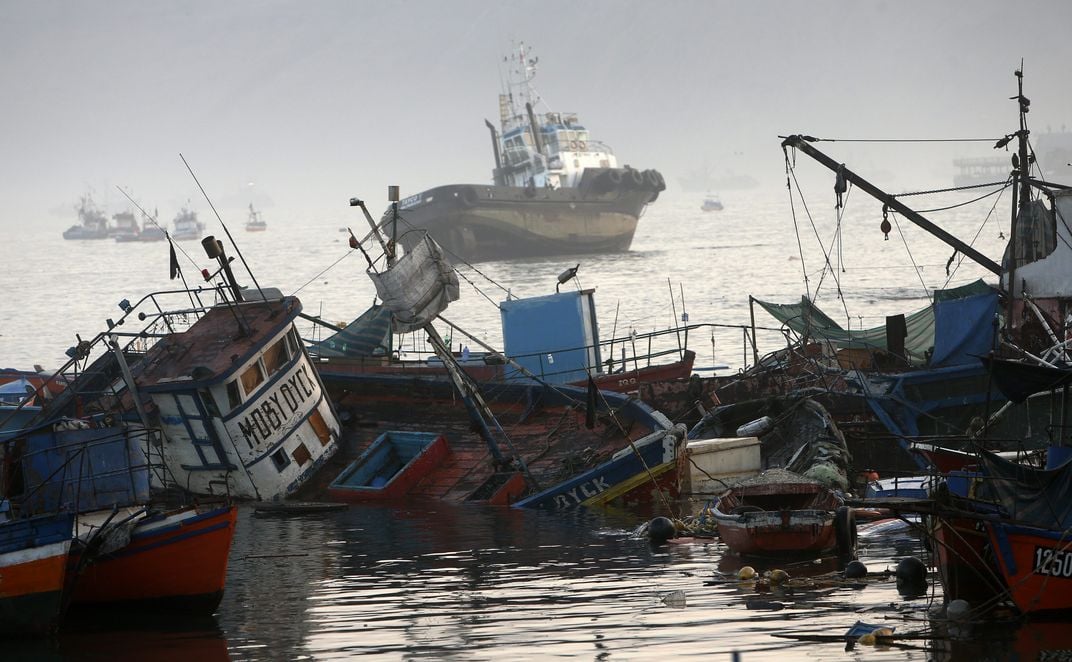Lingering Stress Hints at the Next Giant Earthquake in Chile
A section of the South American tectonic plate holds the potential for a massive quake in the near future
:focal(1266x733:1267x734)/https://tf-cmsv2-smithsonianmag-media.s3.amazonaws.com/filer/e1/79/e1795621-2197-4223-baab-ac3c2a52742f/42-57326073.jpg)
For the past few decades, northern Chile has been anticipating its next massive earthquake. But the destructive temblor that struck in April was not the one geologists were looking for. Analysis of that costly quake has revealed that the region still holds enough strain for an earthquake close to magnitude-9, and it could strike sometime in the near future.
Chile is no stranger to earthquakes. The country perches on the edge of the South American plate, where the neighboring Nazca plate dives beneath it in a process called subduction. This meeting of tectonic titans has given rise to several powerful earthquakes, including the largest ever recorded anywhere in the world, a magnitude-9.5 quake in 1960 that killed 1,655 people and left another 2 million homeless.
In northern Chile, one section of the plate boundary had its last major event in 1877, a magnitude-8.8 quake that spawned a 79-foot tsunami, causing deaths as far away as Hawaii and Japan. Based on the past 500 years of seismic activity in this region, geologists have calculated that an event like the 1877 quake should happen every 111 years or so, meaning the region has been overdue for another Big One.
On April 1, a magnitude-8.2 earthquake struck just off the coast of Iquique, a major port and the hub of the nation’s copper mining industry. People on the coast experienced severe shaking, which damaged or destroyed some 13,000 homes, killed six people and sparked a 6.5-foot tsunami. Damage was totaled at around $100 million or more.
“Generally after earthquakes this large, people close to the event think it unlikely that they could experience other similar events in the near future,” says Gavin Hayes, a geophysicist at the U.S. Geological Survey and lead author on one of the two studies. But that event wasn’t enough to fully relieve the tectonic strain, Hayes and other scientists say in two studies published today in the journal Nature.

Hayes and his team assessed the seismic activity of the April quake and the smaller foreshocks that preceded it. They found that the buildup of activity in the region began in August 2013, and the frequency of earthquakes greater than magnitude-3.5 increased by 950 percent. But the combined energy in all the quakes in the sequence equaled an event of only magnitude-8.3, much smaller than the 1877 quake.
“The subduction zone adjacent to northern Chile has not released all of its accumulated strain and thus could host events of a similar size, or larger in size, to what we have just experienced,” Hayes says.
In the second study, Bernd Schurr of the GFZ German Research Centre for Geosciences in Potsdam and his colleagues made use of data from the Integrated Plate Boundary Observatory Chile. Researchers have been setting up this network of instruments since 2007 in anticipation of an event like the one in 1877. Schurr’s group concludes that the April quake released energy in only one-third of the area, and the rest holds a significant seismic hazard, with the potential for an earthquake greater than magnitude-8.5.
While those can be scary predictions for Chile, Hayes notes that the magnitude of a quake is only one piece of the puzzle when it comes to assessing the danger from a shaking planet. The 2010 Haiti earthquake was a magnitude-7 that caused at least 100,000 deaths. A magnitude-8.8 quake in Chile that same year killed 525, half from a related tsunami. “Size is not the only thing that matters,” Hayes says.
His group adds that the latest research poses a difficult challenge to seismologists in communicating the uncertain yet elevated hazard of another Big One in Chile without appearing alarmist. Such messages have surely become more complicated for seismologists after their Italian brethren were convicted of manslaughter in 2012 for underestimating seismic risk in advance of a 2009 quake in the city of L’Aquila.
“The biggest difficultly is that we don't have any good sense of when this [large earthquake] will happen,” Hayes says. “So the message needs to be to remain vigilant … people in northern Chile should in essence be as prepared as they were prior to this 2014 series of events.”
/https://tf-cmsv2-smithsonianmag-media.s3.amazonaws.com/accounts/headshot/Sarah-Zielinski-240.jpg)
/https://tf-cmsv2-smithsonianmag-media.s3.amazonaws.com/accounts/headshot/Sarah-Zielinski-240.jpg)